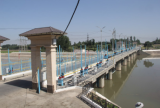JOURNAL OF “IRRIGATION AND MELIORATION”
 Innovative development is based on human resources
Innovative development is based on human resources
The republic's and the neighboring territories' arid and semi-arid climates, where artificial irrigation is the primary method of agricultural production, and the methodical implementation of reclamation measures necessitate the training of qualified specialists with up-to-date scientific knowledge and technological techniques for restoring and sustaining the productivity of irrigated soils under water-limited conditions.
28.10.2023
 BUILDING A 3D MODEL OF HYDRAULIC STRUCTURES USING BIM TECHNOLOGY
BUILDING A 3D MODEL OF HYDRAULIC STRUCTURES USING BIM TECHNOLOGY
J.A.Kasimov is an independent researcher, D. Kalandarova–masret student,
National Research University “Tashkent Institute of Irrigation and Agricultural Mechanization Engineers”
Abstract
In the article, the role of graphic programs in the engineering sciences in the educational system, especially in technical higher education institutions, through them, we can see that the issues related to Build Art technologies, which are the demand of today, can be easily and conveniently solved. The ability to analyze the spatial properties and tasks of subjects is an important component of the graphic preparation of students. In the field of graphic education, development of students' spatial imagination, imaginative analysis of spatial images, activation of mental and cognitive activities of students, development of spatial thinking and imagination, imaginative observation and acceptance of spatial phenomena, shapes, and acquisition of all graphic knowledge and skills, keeping in memory creative qualities such as staying have been adding a significant share to the creation of content.
Key words: BIM (Building Information Modeling), Graphical programs, education, analysis and results, hydrotechnical structures, 3D model, engineering computer graphics
16.06.2023
 DETERMINATION OF ENERGY SAVING WHILE PROVIDING A STABLE OPERATION MODE BY MATHEMATICAL MODELING OF STATIC AND DYNAMIC MODES OF ASYNCHRONOUS MOTOR OF EQUIPMENT FOR GRINDING FORAGE
DETERMINATION OF ENERGY SAVING WHILE PROVIDING A STABLE OPERATION MODE BY MATHEMATICAL MODELING OF STATIC AND DYNAMIC MODES OF ASYNCHRONOUS MOTOR OF EQUIPMENT FOR GRINDING FORAGE
N.B.Pirmatov – Doctor of Technical Sciences, Professor of the Tashkent State Technical University named after I. Karimov,
A.T.Panoev – PhD., Associate Professor of the Bukhara Institute of Natural Resource Management national research university "Tashkent Institute of Irrigation and Agricultural Mechanization Engineers"
Abstract
The article presents energy efficiency by controlling the rotational speed of the asynchronous electric motor of feed grinding devices. With the help of frequency converters, you can directly control the speed by changing the frequency of the electric motor. One of the advantages of this method is that since there is a close relationship between current and torque, the frequency converter can reduce the starting current when starting the motor. When starting the engine, the engine starts smoothly and saves electricity during starting. The power factor of the universal feed grinder was calculated and analyzed by mathematical modeling using the Hurwitz criterion at 100. At the same time, in the electric drive system - the universal feeding grinder, the gain factor - 3.95 < Ку < 895 is provided for operation in a stable mode. The asynchronous motor of the universal feed chopper is optimally controlled in static and dynamic modes. Thanks to frequency control, electricity consumption can be reduced by up to 20%, and 25,920 kWt*h of electricity can be saved per year.
Key words: energy saving, electric drive, frequency converter, optimal control, operating mechanisms, energy efficiency, efficiency.
16.06.2023
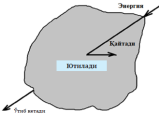 THEORETICAL SUBSTANTIATION OF THE EFFECT OF TREATMENT WITH ALTERNATING ELECTRIC CURRENT ON THE VIABILITY OF GRAPEVINE CUTTINGS
THEORETICAL SUBSTANTIATION OF THE EFFECT OF TREATMENT WITH ALTERNATING ELECTRIC CURRENT ON THE VIABILITY OF GRAPEVINE CUTTINGS
N.M.Markaev – PhD, Senior Lecturer,
NRU “Tashkent Institute of Irrigation and Agricultural Mechanization Engineers”
Abstract
The article studies the energy properties of energy input into cuttings during electrical processing of a grape stem, taking into account the state of the system in two media (water and cuttings). It has been established that the energy absorbed by grape stems depends on the electrical conductivity of the cuttings (γ1), the volume concentration of the cuttings (X1), the conductivity of the electrically conductive liquid (γ2) and the volumetric concentration of the electrically conductive liquid (X2). As a result, it was determined that the two-environment system, i.e. the ratio between the volume concentration of grape cuttings (X1) and the volume concentration of the electrically conductive liquid (X2) is (X1 + X2 = 1), the diameter of the cuttings is in the range of 1.2-1.5 cm, the value of the cross-sectional surface (S) varies within 113.04-76.625 mm2, the electrical resistivity of the handle varies within 106.73-164.85 Ohm-m, also with the exposure time (τ) of the electric current, it is necessary to take into account the distance between electrodes placed in the working chamber (l), processing voltage (U).
Key words: electrodes, grape cuttings, electric current, electromagnetic field, conductivity, electrical resistivity, volumetric concentration.
16.06.2023
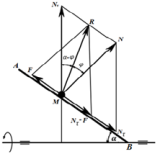 JUSTIFICATION OF THE PARAMETERS OF THE WORKING BODY OF THE DEVICE FOR LOCAL APPLICATION OF MANURE DURING THE FORMATION OF RIDGES
JUSTIFICATION OF THE PARAMETERS OF THE WORKING BODY OF THE DEVICE FOR LOCAL APPLICATION OF MANURE DURING THE FORMATION OF RIDGES
B.M.Khudayarov – D.S.C., professor, U.T.Kuziev – PhD associate professor, National research university “Tashkent institute of irrigation and agricultural mechanization engineers” ,
U.I.Abdumalikov – doctoral student Andijan institute of agricultural and agrotechnology
Abstract
The article presents the results of research on the substantiation of the parameters of the working body, provides information on the design of the device and its technological process of local application of semi-ripened manure of the newly formed comb on the basis of the machine for the formation of ridges.
The parameters of the blade auger feeding manure in the prescribed norm from the hopper are determined, including the rate of departure of manure particles from the blades and its pitch, the angle of installation of the blades to the shaft, the shape and dimensions of the blades.
According to the results of the research, the shape of the blade was determined, which has the form of a circle sector with a radius of 0.15 m, its area is 0.00595 m2, the angle of the blade to the shaft is 45 degrees, the width of the blade is equal to its pitch and is equal to 87 mm.With these parameters, all the requirements set for the blade auger are met.
Key words: manure, bunker, paddle auger, fence, hole, guide troughs.
16.06.2023
 DEVELOPMENT AND RESEARCH OF THE METHOD OF STATIC SYSTEMS IDENTIFICATION BY HYSTERESIS
DEVELOPMENT AND RESEARCH OF THE METHOD OF STATIC SYSTEMS IDENTIFICATION BY HYSTERESIS
B.A.Khudayarov – DSc, professor, F.Zh.Turaev – senior teacher,
“Tashkent Institute of Irrigation and Agricultural Mechanization Engineers” National Research University
Abstract
The paper considers methods for constructing and numerical realization of a hysteresis model for engineering systems. Mathematical models based on the analytical representation of the hysteresis characteristics of linear systems obtained by specifying piecewise linear signals at their input with different velocities of both signs on linear sections are proposed. For a more accurate description of the hysteresis characteristics of static systems that actually occur in practice, in a number of cases, differential equations of higher order are used, in particular, equations of the second order. The use of differential equations of higher order makes it possible to simulate cyclically unstable hysteresis, when the shape and slope of the hysteresis curves can change from a cycle to a number of cycles. For some systems, this process ends after a certain number of cycles (there is a so-called transient process in the phenomenon of hysteresis, in electrical engineering, it is called accommodation in relation to magnetic elements), for other systems this process of cyclic instability of hysteresis can be observed for any length of time. Methods for identifying static objects by hysteresis were developed and investigated.
Key words: hysteresis, integral model, Rayleigh-Masing principle, differential equations, numerical model, input signal.
16.06.2023
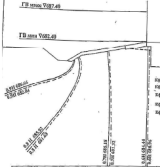 SIMULATION OF FILTRATION FLOWS UNDER THE BASE OF THE SARYKURGAN HYDROPOWER STRUCTURES
SIMULATION OF FILTRATION FLOWS UNDER THE BASE OF THE SARYKURGAN HYDROPOWER STRUCTURES
B.K.Sаliyev – DSc, Associate Professor, E.I. Berdiyorov – doktorat, M.B.Saliyeva, R.I.Turaxonov – independents researcher,
Research Institute of Irrigation and Water Problems
Abstract
The article discusses the technical condition of hydroelectric facilities that have been in operation for 77 years, the causes of
filtration processes under the dam, the dissolution of lime, sand and soil particles between rocks, and the issues of groundwater
seepage. Also, groundwater replenishment comes from seepage flows from under the Sarykurgan hydroelectric complex built
on the Sokh River, the riverbed and irrigation systems, as well as water absorption from irrigated areas. Modeling of filtration
flows under the base of the hydroelectric complex was carried out using the EGDA method. according to the results of the water
balance, the runoff from the valley of the river. The dry area of the left bank of the Great Fergana Canal is 8.1 m3/s, the right
bank zone is 9.346 m3/s.
Key words: hydraulic system, design, cone propagation, filtration, hydrodynamics, model.
16.06.2023
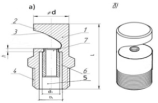 RESULTS OF EXPERIMENTAL STUDIES OF SPRINKLING IRRIGATION DEVICES
RESULTS OF EXPERIMENTAL STUDIES OF SPRINKLING IRRIGATION DEVICES
Z.J.Khudoyorov – PhD, associate professor,
Tashkent State Agrarian University
Abstract
The article presents the results of experimental studies of sprinkler irrigation devices for agricultural crops. The flight
distance of raindrops and the process of sprinkling irrigation were analyzed using the regression equation obtained as a result of
a multivariate experiment. A technical solution has been developed for the structural and functional structures of the deflector
nozzle, which carry out the sprinkling process at low pressure. As a result of the research, the pressure in the nozzle hydraulic
system was reduced from 0.1-0.3 MPa to 0.065 MPa. Due to low-pressure irrigation, a drop of water in the sector of the field surface
has a flight range equal to L=3.3-4.4 meters, and the width of the irrigation zone is Δ=1.1 meters. In this case, the theoretical value
of the flight time of a water drop is 0.47-0.58 s.
Key words: sprinkler irrigation, raindrop, range, nozzle, sprinkler device, water head, hydraulic system of nozzle, deflector.
16.06.2023
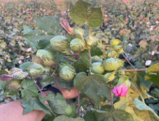 THE IMPORTANCE OF DRIP IRRIGATION OF COTTON IN THE CONDITION OF TYPICAL SIEROZEM SOILS OF THE CHIRCHIK-OKHANGARON OASIS
THE IMPORTANCE OF DRIP IRRIGATION OF COTTON IN THE CONDITION OF TYPICAL SIEROZEM SOILS OF THE CHIRCHIK-OKHANGARON OASIS
A.B.Mamataliyev – associate professor, M.A.Malikova – master student,
National Research University "Tashkent Institute of Irrigation and Agricultural Mechanization Engineers"
Abstract
Today, in many countries of the world, disruption of the natural balance, climate change is becoming a factor that can have a significant impact on all areas of human activity. In particular, a 10-15 percent increase in water evaporation as a result of climate change will lead to 10-20 percent more water use due to plant transpiration and increased irrigation rates. In order to effectively use the available water resources, research was conducted to study irrigation methods and the effect on the growth, development and productivity of the cotton variety "Namangan-77" in the conditions of the typical sierozem soils of the Chirchik-Okhangaron Oasis using drip irrigation technology. The influence of irrigation methods on water-physical properties of the soil, including water permeability, was considered. The article contains information on the norms, duration, number, period between irrigations and the duration of irrigations when the soil moisture before irrigation of "Namangan-77" cotton variety is in the order of 70-70-60% relative to Fc in typical sierozem soils. At the same time, the results of phenological observation of cotton are presented and compared according to irrigation methods.
Key words: cotton, typical sierozem soils, drip irrigation, horizontal irrigation, irrigation scheduling, irrigation rate, productivity.
16.06.2023
 HYDRAULIC MODEL OF REGULATION OF RIVER SEDIMENTS IN RESERVOIRS
HYDRAULIC MODEL OF REGULATION OF RIVER SEDIMENTS IN RESERVOIRS
A.M.Arifjanov – d.s.c., professor, S.N.Xoshimov – PhD., associate professor,
"Tashkent Institute of Irrigation and Agricultural Mechanization Engineers" National research university
Abstract
The article presents an analysis of practical and theoretical studies on measures to reduce the process of siltation of reservoir bowls. The useful volume of run of-river reservoirs is rapidly decreasing due to mudflows and floods, so the protection of run-of-river reservoirs from silting, as well as reducing the process of silting, is one of the most urgent problems. Based on the analysis of the measurement work carried out at the study site, it was established that during one season, along with the runoff, 170-180 thousand m3 of sediment enters the Chartak reservoir, an analysis was made of the amount and fractional composition of the incoming sediment. According to field studies conducted in the Chartak reservoir and the developments of a number of scientists in this field, the size of more than (d> 0.2 mm) was taken beyond the limit of bottom and suspended sediments, so the calculations were carried out for particles with a fraction of d≥0.2 mm. Based on theoretical and practical studies, the parameters of the settling tank, which is proposed to be built at the entrance to the reservoir, in accordance with the particle size of the fraction (d> 0.2 mm), the following are proposed: settling tank length L=375 m, average width B= 230 m, average depth h=1.5 m. The proposed sump is cleaned seasonally, during the growing season, that is, after the reservoir is emptied, it is recommended that sediments settled in the sump be cleaned mechanically.
Key words: reservoir, sump, channel, stream, pool, sediments, usable volume, water level
16.06.2023
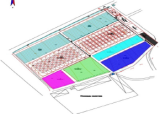 EFFICIENCY OF THE SPRINKLIN G IRRIGATION METHOD FOR IRRIGATION OF SOYAN “NAFIS” AND CAULIFLOW PLANTS “RASKOT”
EFFICIENCY OF THE SPRINKLIN G IRRIGATION METHOD FOR IRRIGATION OF SOYAN “NAFIS” AND CAULIFLOW PLANTS “RASKOT”
S.Х.Isaev – Doctor of Agricultural Sciences, Professor, NRU “TIIAME”, Kh.S.Khusanbaeva – doctorant, CBSPARI,
S.А.Dostnazarova – doctorant, NRU “TIIAME”, J.D.Narzullaev – doctorant, NRU“TIIAME”.
Abstract
As you know, if you look at the analysis of climate change in subsequent years, then fresh water indicators from 1960 to 2014, 70%
of the total fresh water consumption accounted for agriculture and animal husbandry, of which 20% is irrigated agricultural land, and
on these lands produces 40% of the total food production. In order to reduce the population's in the Tashkent reion, the method was
used for soybean crops "Nafis" variety was applied, watered accordin to the 3-5-5 scheme durin the rowing season, irriation rates werw
220–230 m3/ha, irrigation rates were 2880 m3/ha, in the color carousta variety Rаskot" 2-4-5 during the growin season in the sustem,
irriation rates are 220–225 m3/ha, irrigation rates are 2440 m3/ha of irrigation.
Key words: soybean and cauliflower species, sprinkling irrigation method, soil bulk density, soil porosity, soil water permeability,
field capacity limit, irrigation rates, irrigation timing, irrigation rate, growth development of soybeans and cauliflower, crop yields.
16.06.2023
 OBJECTIVES OF THE FACULTY IN THE DEVELOPMENT LAND USE IN THE REPUBLIC
OBJECTIVES OF THE FACULTY IN THE DEVELOPMENT LAND USE IN THE REPUBLIC
A.S.Chertovitsky – professor, “Tashkent Institute of Irrigation and Agricultural Mechanization Engineers” National research
university
Abstract
The article provides an analysis of the state of research activities at the faculty, noted the lack of coordination of research
work on the fundamentals of land use, their connection with policy documents on the development of land use and agriculture.
Particularly noted is the poor training of scientific personnel in economic sciences, the main objectives of research to improve
the efficiency of land use in an innovative and market economy are formulated.
The issues of training personnel for production were also analyzed, weaknesses in the structure of the faculty and the
disciplines studied were identified, and their insufficiently close connection with the types of production work was noted. New
directions and disciplines are recommended in accordance with the objectives of the ongoing land reform
Key words: faculty, land use, research, innovations, disciplines, modernization, land resources, efficiency.
14.06.2023
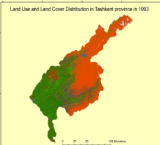 DETECTION OF CHANGES IN THE LAND COVER OF TASHKENT REGION BY REMOTE SENSING
DETECTION OF CHANGES IN THE LAND COVER OF TASHKENT REGION BY REMOTE SENSING
Sh.Q.Rakhmonov – PhD associate professor, I.O.Bozarov – doctorate, "Tashkent Institute of Irrigation and Agricultural
Mechanization Engineers" National Research University
Abstract
The article describes the conduct of digital monitoring using remote sensing technology on the example of Tashkent region.
The study analyzed the 27-year changes in the land cover of Tashkent region between 1993 and 2020 by remote sensing. In Tashkent
region, the area of settlements has increased by 93065.41 hectares. The decrease in agricultural arable land by 27465.4 hectares
was analyzed using the ArcGIS program. The result of changes in ground cover was brought to the map view. USGS Landsat 4-5 TM
C2 L2 collection was used. For analysis, 9 land types were conditionally selected and analyzed using the “Interactive supervised
classification” classification. It is recommended that this research methodology be applied in other regions as well.
Key words: remote sensing, satellite imagery, Landsat, land fund, vegetation cover, land monitoring, agricultural land, water
fund land, settlement land.
14.06.2023
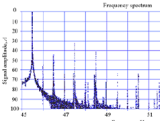 ANALYSIS OF DIAGNOSTICS AND PROTECTION METHODS OF ASYNCHRONOUS MOTORS USED IN AGRICULTURE, BY VIBRO-INDICATORS
ANALYSIS OF DIAGNOSTICS AND PROTECTION METHODS OF ASYNCHRONOUS MOTORS USED IN AGRICULTURE, BY VIBRO-INDICATORS
M.Ibragimov – associate professor, c.t.s, D.M.Akbarov – doctoral student,
National Research University “Tashkent Institute of Irrigation and Agricultural Mechanization Engineers”
Abstract
Nowadays, AC motors are in great demand among most modern manufacturing enterprises. Professional experience shows
that they use 80% of all electricity generated in the country, so the stability of their work plays an important role in agriculture and
industry. Nowadays, vibration diagnostics is one of the effective tools for solving a wide range of problems of detecting defects in
electrical machines, preventing parts from failing, extending their service life and increasing their overhaul periods of operation.
Preservation of electrical safety, reliability and durability of the operation of electromechanical equipment of electric drives based
on asynchronous motors in the production processes of enterprises in the agricultural industry remains an urgent task of electrical
systems.
Keywords: Asynchronous electric motor, insulation, protection, short circuit, vibration, phase loss, analysis, technological
process, voltage, current.
14.06.2023
 METHOD FOR WATER DISINFECTION AND METHOD FOR INCREASING NUTRIENTS IN WATER FOR PLANTS USING ELECTROHYDRAULIC EFFECT
METHOD FOR WATER DISINFECTION AND METHOD FOR INCREASING NUTRIENTS IN WATER FOR PLANTS USING ELECTROHYDRAULIC EFFECT
А.А.Turdibaev – PhD, Associate Professor, N.А.Aytbaev – doctoral student, D.M.Akbarov – doctoral student National
Research University “Tashkent Institute of Irrigation and Agricultural Mechanization Engineers”
Abstract.
The article describes the possibility of using the electro-hydraulic effect to neutralize wastewater and increase the amount
of nitrates in water for crops. It is characterized by the formation of chemical processes in water, an electro-hydraulic effect,
which is carried out in conjunction with ultrasound and ultraviolet radiation. The amount of nitrates in the water is 1.1 mg/l
with pre-treatment of water with an electro-hydraulic effect of 2.23 mg/l. to 102.7%, while the neutralization of E. coli bacteria
in purified water decreased from 3474 (c.u.) to 610 (c.u.), i.e. up to 82.55 compared to control. Increasing the content of nitrates
in water and neutralizing E. soli (E. coli) bacteria depend on the treatment time, discharge voltage, capacitor capacity, discharge interval and the number of pulses in the electro-hydraulic treatment, which is carried out in conjunction with ultrasound and
ultraviolet radiation, causing a chemical reaction of electro-hydraulic shock in water. Discharge voltage to increase 9-15 kV.
Processing time 100-120 minutes, depending on the processing voltage, it is recommended to have a capacitor capacitance of
0.8uF, a discharge interval of 10-12mm.
Key words: electrohydraulic effect, nitrates, E. coli bacteria, water neutralization discharge voltage, air gap, capacitor
capacitance, working distance between inductive electrodes, treatment time.
14.06.2023
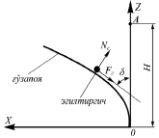 THE DEPENDENCE OF THE BENDING FORCE OF A COTTON STOCK ON ITS MORPHOLOGY AND THE STEM BEND
THE DEPENDENCE OF THE BENDING FORCE OF A COTTON STOCK ON ITS MORPHOLOGY AND THE STEM BEND
B.Khudayarov – doctor of technical sciences, professor, U.Kuziev – PhD., associate professor ,“Tashkent Institute of Irrigation
and Agricultural Mechanization Engineers” National Research University
Abstract
In article as an object of research, the process of bending cotton stalks, located on the ridges in a vertical position, the technological
and design parameters of the stalk bender for its implementation, was taken. The laying of cotton stalks on the side furrow in
the direction of movement of the unit is the beginning of the technological process of the proposed technology. The qualitative
performance of the process is assessed by laying cotton stalks on the bottom of the side furrow along its axis of symmetry. The laying
of cotton stalks relative to the axis of symmetry of the furrow up to 30° satisfies the stated requirement. In this case, embedded cotton
stalks in the future will not interfere with the implementation of technological processes in the inter-row processing of cotton.
When conducting research, the laws of theoretical and agricultural mechanics and methods of mathematical planning of
experiments were applied. The value of the acting force from the cotton stalks on the stalk bender is determined depending on the elasticity, size and
properties, as well as the installation height of the stalk bender in the process of bending the stems on the side furrow. The results are
analyzed by the structure of their graphs. By conducting field experiments, the influence of the angle and height of the installation
of the stalk bender on the value of the bending force is substantiated. Based on the results of theoretical and experimental studies,
the radius of curvature of the stalk bender r=96 mm, the height of its installation from the surface of the ridge h=15 cm and the
angle in the direction of movement of the unit γ=43°for laying cotton stalks along the axis of the furrow with a minimum angle were
determined.
Key words: stem, stalk bender, bending force, tilt angle, friction angle, furrow bottom, furrow axis.
14.06.2023
 INFLUENCE OF THE WIDTH OF AN ARCUSHED SHAREL AND THE DEPTH OF SOIL PROCESSING ON ITS DRIVING RESISTANCE
INFLUENCE OF THE WIDTH OF AN ARCUSHED SHAREL AND THE DEPTH OF SOIL PROCESSING ON ITS DRIVING RESISTANCE
T.S.Khudoyberdiev – DSc. Professor,
A.M.Abdumannopov – basic doctoral student, Andijan Institute of Agriculture and Agrotechnology
Abstract
In the aisles of fruit tree seedlings in new gardens, you can receive additional income for 5–8 years due to sowing and growing
various vegetable and melon crops, however, most farms do not use this opportunity. The reason for this is that in order to prepare
for sowing, the soil plowed in early spring in the rows of gardens must be loosened, large clods crushed, the surface leveled and
irrigation furrows cut. When performing these works, at present, a separate passage of the corresponding agricultural unit is
required for each technological process. And this leads to an increase in labor costs, time and energy resources. Taking into account
the above, this article presents the results of research on the design of a combined unit that performs in one pass the entire range
of work on preparing the soil for sowing when growing vegetable-melon crops in the aisles of the garden, as well as determining
some parameters of workers. It is known that the main energy indicator of this working body is the traction resistance, which
mainly depends on its design and technological parameters. In this regard, in the work, based on the study of the effect on the
traction indicators of the working body of its width and depth of tillage, it is solved graphically. Solving the dependency graphically
allows you to better understand its meaning, the task is greatly simplified and other researchers can also use it, which increases the
versatility of this method. As a result of calculations, using the graphical method, the values of traction resistances for two variants
of the sizes of the pointed arc-shaped paw were determined, i.e. 1) b= 0.22 m; h= 0.2 m; 2) b= 0.25 m; h=0.15 m - R1 =1040.8 N;
R2=943.2 N, respectively.
Keywords: working body, traction resistance, design, arched lancet share, depth and width of processing, soil deformation, soil
density, soil moisture and agrotechnical requirements
14.06.2023
 PHYSICAL MODIFICATION OF CONCRETE MIX AND CONCRETE IN THE PROCESS OF VIBRO-IMPACT PRESSING
PHYSICAL MODIFICATION OF CONCRETE MIX AND CONCRETE IN THE PROCESS OF VIBRO-IMPACT PRESSING
B.B.Khasanov – Doctor of Technical Sciences, Professor, M.Z.Rajabov – Assistant, Tashkent Institute of Irrigation and
Agricultural Mechanization Engineers National Research University.
Abstract
Numerous studies have established that the physical and mechanical properties of concrete, in addition to the activity of
cement, the type of aggregates, etc. are determined by the value In / C of the concrete mixture. The dependence of the strength and
water resistance of concrete on the I / C follows from the physical essence of the formation of the concrete structure. The study of
the cement hydration process showed that cement, depending on the quality and hardening period, binds only 15...25% of water
from its mass. During the first month, at least 20% of the water from the cement mass binds. At the same time, to give the concrete
mixture plasticity, to improve the conditions of hydration of the binder, a much larger amount of water is introduced, since at (V /
C) n = 0.20, the concrete mixture remains practically dry and it is impossible to lay, mold and compact it qualitatively. Excess water,
without entering into chemical reactions with cement, remains in concrete in the form of water pores and capillaries or evaporates,
leaving air pores. Undoubtedly, this is the main reason for the decrease in the strength and water resistance of concrete.
Key words: modification, hydration, workability, concrete mix, structure, properties, strength, water resistance, porosity,
density, dehydration, filtration, centrifugation, vacuuming, vibropressing, vibration impact pressing.
14.06.2023
 AUTOMATIC WATER LEVEL CONTROLLER WITH FLEXIBLE WORKING BODIES FOR BLOCKING STRUCTURES ON CANALS AND ITS CAPACITY
AUTOMATIC WATER LEVEL CONTROLLER WITH FLEXIBLE WORKING BODIES FOR BLOCKING STRUCTURES ON CANALS AND ITS CAPACITY
M.A.Kadirova – c.t.s., Associate Professor National Research University "Tashkent Institute of Irrigation and Agricultural
Mechanization Engineers"
Abstract
The study was carried out on an experimental installation by the method of physical modeling. As a result of studies of the
model in the form of a board with fixed angles of inclination to the horizon from 6 degrees to 40 degrees, graphs of the dependences
of the values of its flow coefficients in the absence of lateral outflows were constructed depending on its angle of inclination and
the height of the hole of the board divided by the depth of water in front of it.As a result of studies of the water level autoregulator
model, a formula was obtained to determine the ratio of the flow rate of lateral outflows to the total flow passing through its flap,
depending on the height of the flap opening divided by the depth of water in front of it. At the same time, the spread of the obtained
points by the values of the flow coefficient in relation to the curves of the constructed graph was + 4...5 percent. In addition,
studies were conducted on errors in the accuracy of regulation of a given water depth in front of the water level autoregulator. They
showed that this error in the accuracy of regulation is no more than + 5. This automatic water level controller provides automatic
regulation of the water level in the channel in front of the blocking structure, automatic discharge of excess water and washing of deposits to prevent their accumulation and deposition in front of the partition structure.
Key words: hydraulic gate, flat pressure board, non-pressure and side parts, level regulator, rubberized meliorative fabric, side
outflows.
14.06.2023



